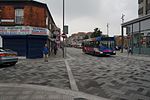Hainton Street Halt railway station
Hainton Street Halt was a railway halt on the East Lincolnshire Railway which served the Welholme Road area of Grimsby in Lincolnshire between 1905 and 1961. The station was opened as part of a new motor train service between Grimsby and Louth. The station briefly closed in 1939 as a Second World War economy measure, but reopened in 1940. The line through Hainton Street remained open for freight until December 1980. The trackbed was later reused by Humberside County Council to construct the A16 Peaks Parkway which now runs through the site. Building of the road put an end to the aspirations of the Great Northern and East Lincolnshire Railway plc (now the Lincolnshire Wolds Railway) to reopen the line as a heritage railway.
Excerpt from the Wikipedia article Hainton Street Halt railway station (License: CC BY-SA 3.0, Authors).Hainton Street Halt railway station
Peaks Parkway,
Geographical coordinates (GPS) Address Nearby Places Show on map
Geographical coordinates (GPS)
| Latitude | Longitude |
|---|---|
| N 53.5585 ° | E -0.0779 ° |
Address
Peaks Parkway
Peaks Parkway
DN32 9LN , Holme Hill
England, United Kingdom
Open on Google Maps







